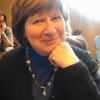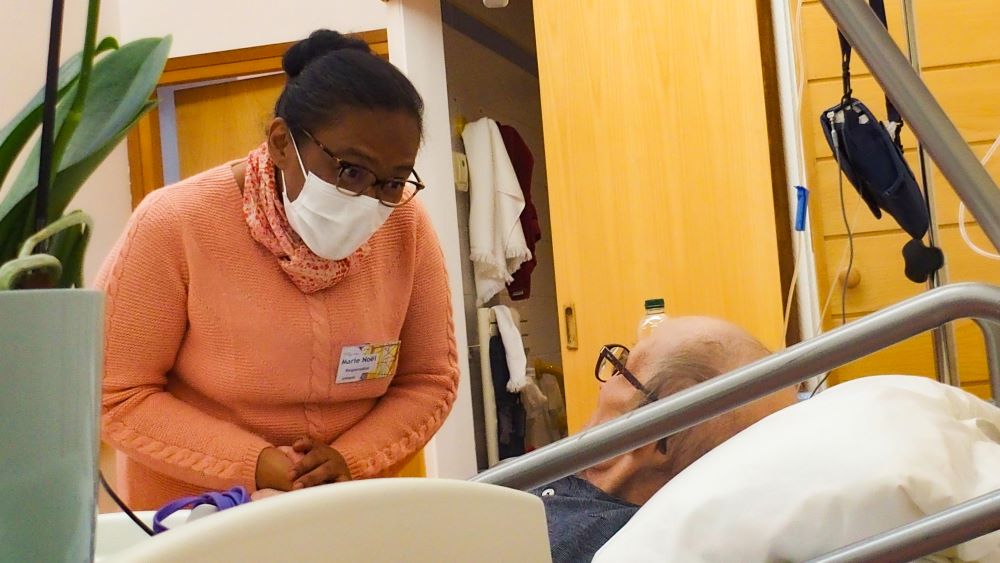
Xavière Sr. Marie-Noël Ratsimbazafy visits a patient at Maison Médicale Jeanne Garnier. She heads the chaplaincy, assisted by volunteers who visit patients requesting religious help. Rabbis and imams are also called if needed. (Courtesy of La Xavière)
Women religious, who have played a key role in the development of palliative care in France, are concerned that a bill parliament is due to discuss later this year could legalize euthanasia.
Currently, euthanasia is considered murder in France. Yet many opinion polls show that a majority of respondents support a new law allowing euthanasia under certain circumstances. In an IFOP poll, one of the main polling institutes in France, 70% said they would be in favor of a law allowing "an active help to die" legalizing euthanasia. In that same poll, a majority — 54% — favored the right of doctors to refuse to administer euthanasia.
Doctors and nurses have repeatedly expressed their opposition to giving a means of death to anyone. An alternative, particularly with a growing aging population, many say, would be to expand the role of palliative care. Such care allows deep sedation for people at the very end of life, but in France it can only be administered when death can be foreseen within days.
Palliative care is intended to relieve pain, while euthanasia — the policy parliament is considering — is intended to cause death. A 2016 law allows doctors to keep terminally ill patients sedated until death — but stops short of legalising euthanasia or assisted suicide.
That law aimed to develop more palliative care options. But seven years later, there are still not enough palliative care units in the country. Often, hospitals have only a few beds for terminally ill patients, and health care workers are not able to devote enough time to them.
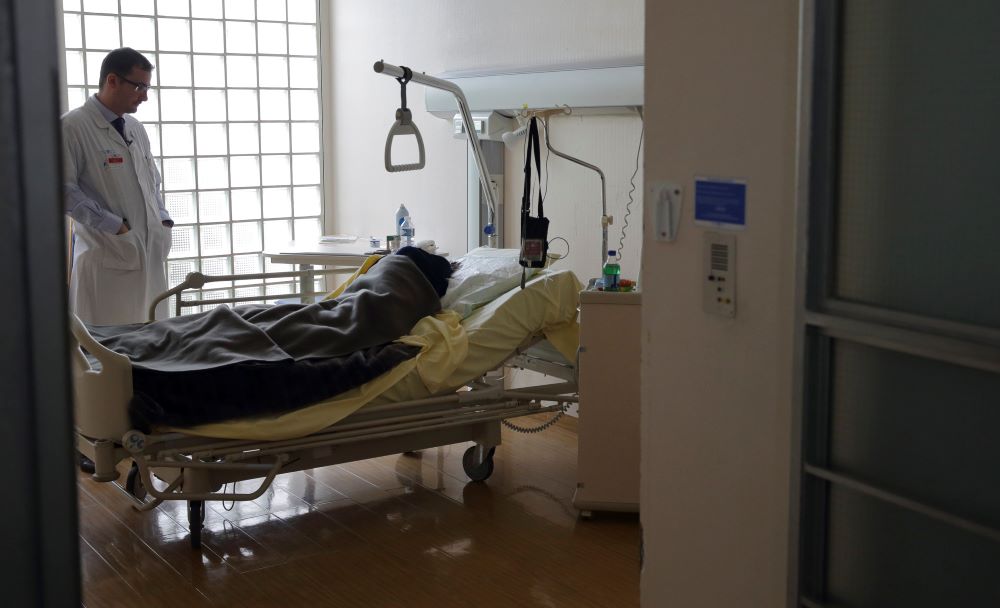
A doctor visits a patient in the palliative care unit of a hospital in Paris March 4, 2015. (CNS/Reuters/Philippe Wojazer)
The biggest and most famous medical center for palliative care in France, and in Europe, is the Maison Médicale Jeanne Garnier, in Paris, with 81 beds. It is named after the woman who created the first home for women dying alone in poverty.
Jeanne Garnier was born Jeanne Chabot in Lyon in 1811. At 20, she married Etienne Garnier, but by age 24, she was mourning both his death and that of her two young children.
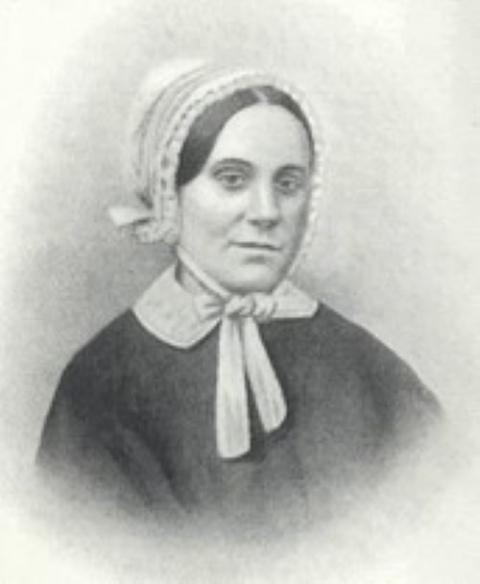
Jeanne Garnier, a widow at 24, devoted her life to women who were sick without hope of recovery. (Wikimedia Commons/Public domain/Federation of Jeanne Garnier Establishments)
She decided to devote her life to women who were sick without hope of recovery. They were not accepted in hospitals, since there was no cure for them, so they often died alone and in poverty. Garnier opened her house to some of them and cared for them until their deaths. She convinced two widowed friends to join her, to take in more women.
With their dedicated home for the dying, palliative care was born in France..
Soon, other widows joined Garnier; together they founded a "pious union" of lay women, the Oeuvre du Calvaire in 1842. It wasn't until 1853 that they could buy their own home. By then, they had cared for 50 sick women. That year, Garnier died, but the Dames du Calvaire continued her work.
The Xavières, successors to the Dames du Calvaire, are on the board of the Maison Jeanne Garnier to guarantee this medical house remains true to its original goal and its charter, which clearly states that no euthanasia is given to patients.
The Xavières' mission is to continue Garnier's work and spirit. "We exercise this responsibility with the board of directors of Dames du Calvaire, of which several Xavières are members," Xavière Sr. Anne Marie Aitken, who lives in the Jeanne Garnier community, told Global Sisters Report. "The board, not the Xavières, make the decisions. The association of the Dames du Calvaire is not a congregation, the Xavière is."
The current debate about a new law allowing euthanasia provoked even more discussions and reflection among doctors, nurses, health care workers and volunteers.
"It is clear for the Maison Jeanne Garnier that killing cannot be considered treatment," Aitken said. "It is also clear that the house will continue to welcome everyone, whatever their social condition, their beliefs, their philosophy, and that they will be listened to all the way."
Patients often change their minds about euthanasia once given medication to alleviate pain, she noted. "A study carried out a few years ago showed that out of 2,000 patients received at Jeanne Garnier, 60 had a request for euthanasia upon arrival but only 6 maintained this request during their stay," she said, adding that the facility could not grant the request. "What these patients ask for above all is consideration of their pain and suffering. As soon as this is relieved, the positions change," she said.
'It is clear for the Maison Jeanne Garnier that killing cannot be considered treatment.'
—Sr. Anne Marie Aitken
Xavière Sr. Mireille Mion works with the 85 volunteers who visit patients at Maison Jeanne Garnier.
"It is very important to listen to patients. When someone says: 'I would like this condition to end,' it doesn't mean: 'I want to die,' " she said. "Others ask for euthanasia knowing very well it is illegal. Listening to what people have to say doesn't mean agreeing with everything they say."
In a recent documentary the Maison Jeanne Garnier created, a nurse described her experience: "I often heard people who came here ask for euthanasia. With the care we gave, our attention, our presence, when we were able to alleviate their pain, physical, moral and spiritual pain, they stopped asking for euthanasia."
Aitkin said that, should the new law pass, she fears "the difficulty of maintaining unity in the services. We can also fear that the most vulnerable people will ask for death because they feel that they are a burden on their loved ones and on society."
Developing more palliative care in France and training doctors and nursing staff is essential, she said, including on the refusal of unreasonable therapies and the proper use of deep sedation.
At the Maison Jeanne Garnier, volunteers, mainly women, take turns visiting patients. They are accepted only after several months' training with a more experienced volunteer to learn how to behave toward patients, families and the health care workers.
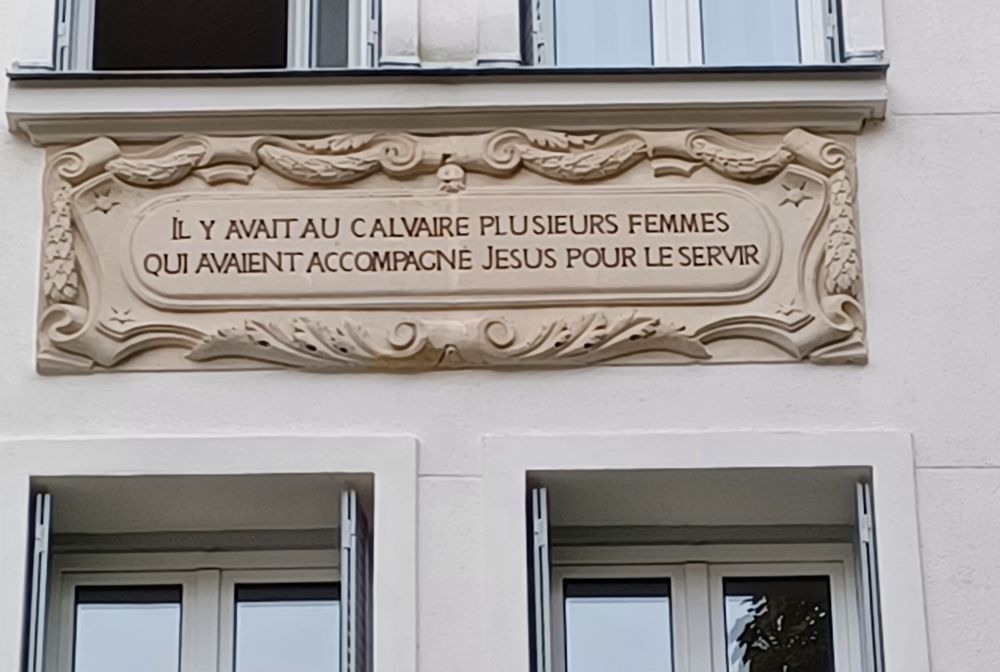
This inscription at Maison Jeanne Garnier in Paris says Il y avait au Calvaire plusieurs femmes qui avaient accompagné Jésus pour le servir (There were at the Calvary several women who had accompanied jesus to serve Him.) (Elisabeth Auvillain)
"COVID changed a lot in the way volunteers are; we could not recruit any new ones for a while. Then, older ones had to leave," Mion explained. In training volunteers, "we have to be very careful to maintain the spirit of Jeanne Garnier."
Every day, at lunchtime, the morning volunteers and those who follow in the afternoon take an hour together to talk about the events of the day. They also attend monthly meetings with a psychologist to share impressions, worries, questions and doubts.
"We are a team, we are not acting individually. When patients ask: Will you come to see me again tomorrow? We answer: One of us will be with you," one longtime volunteer said.
A nearby parish priest ministers to the Maison Jeanne Garnier. The chaplaincy is headed by Xavière Sr. Marie-Noël Ratsimbazafy, with help from a group of volunteers who visit patients who request religious help. Rabbis and imams are also called if needed.
Mass is celebrated in the chapel three times a week and transmitted on the internal TV channel. (Courtesy of Jeanne Garnier Paris)
"When patients arrive here, they are welcomed by health care workers and a volunteer, who tell them about the chapel and the chaplaincy,” Ratsimbazafy told GSR in an interview.
Mass is celebrated three times a week, including the Sunday service on Saturday afternoon, and transmitted on the house's internal TV channel, so patients can watch it in their rooms, she added.
In an interview with the Catholic TV channel KTO, Ratsimbazafy explained the role of the community of the Xavières: "The community of Xavières living at the center is a great support for the chaplaincy, helping to prepare liturgies for religious feasts and Sunday services," she said.
The anointing of the sick is offered. Baptisms and even weddings have been celebrated there. "Families, who often need as much support as the patients, are also met with frequently," Ratsimbazafy said.
Advertisement
Other volunteers take part in the mission of the Maison Jeanne Garnier.
"When AIDs patients came here we noticed most of them were artists so we started art therapy," Xavière Sr, Dr. Marie Sylvie Richard, who worked as a doctor at Jeanne Garnier until recently, said in the documentary.
A nurse also specialized in aromatherapy, which some patients say helps them. A professional cellist visits regularly.
The view of death has changed significantly since Garnier formed the "pious union" in 1842. Medical treatment has improved so much that some doctors and relatives find it hard to accept that there is nothing more to do for the dying. Palliative care workers believe a presence is essential for those who are going to leave this world when no more treatment is possible.
"If you'd like to have coffee, I'll make some for you," a volunteer told two friends of a patient as they were sitting in the hall. "I do not do anything here, I am not a health worker," the volunteer said. "Yes, you do something," one woman replied. "You smile!"
